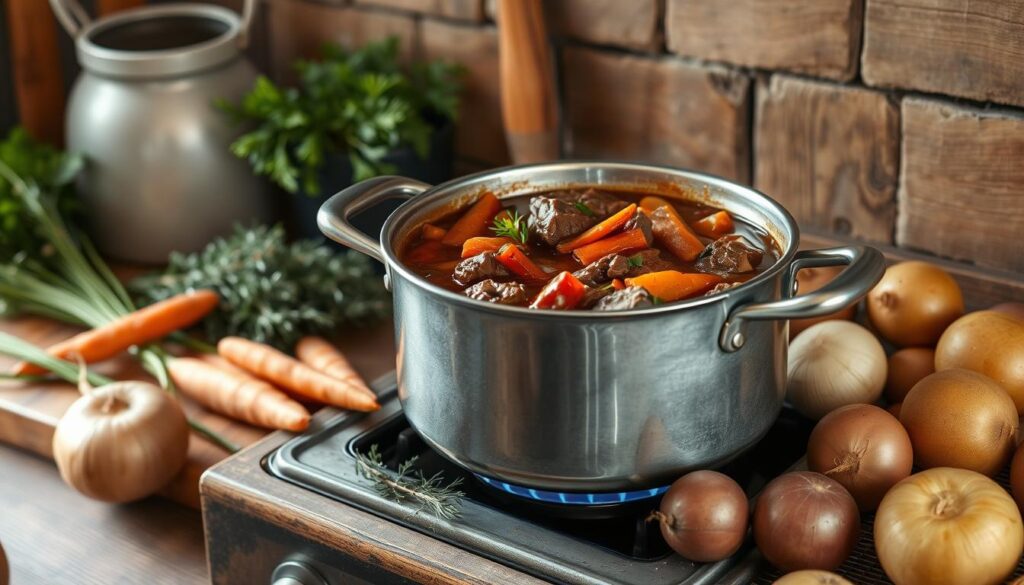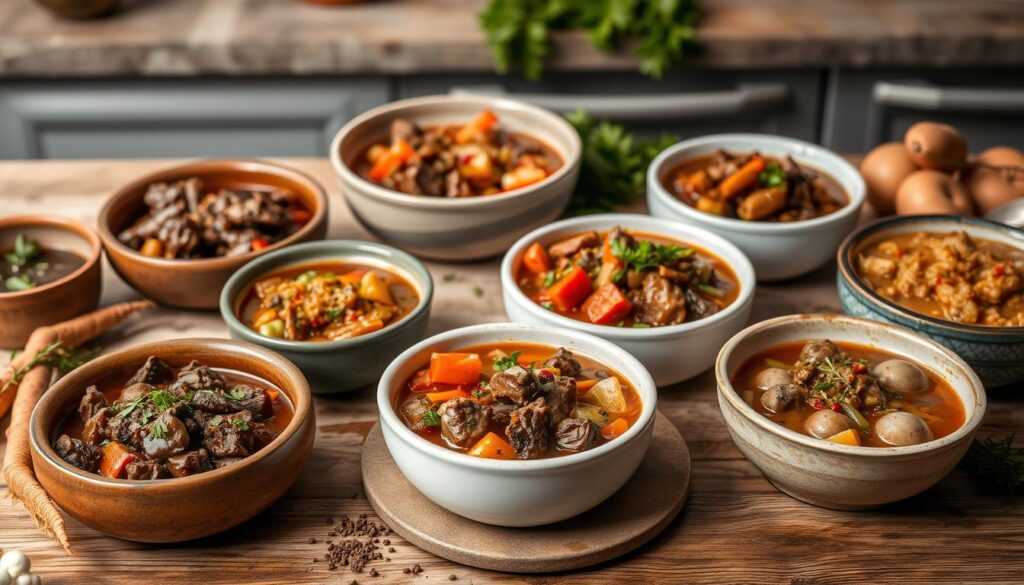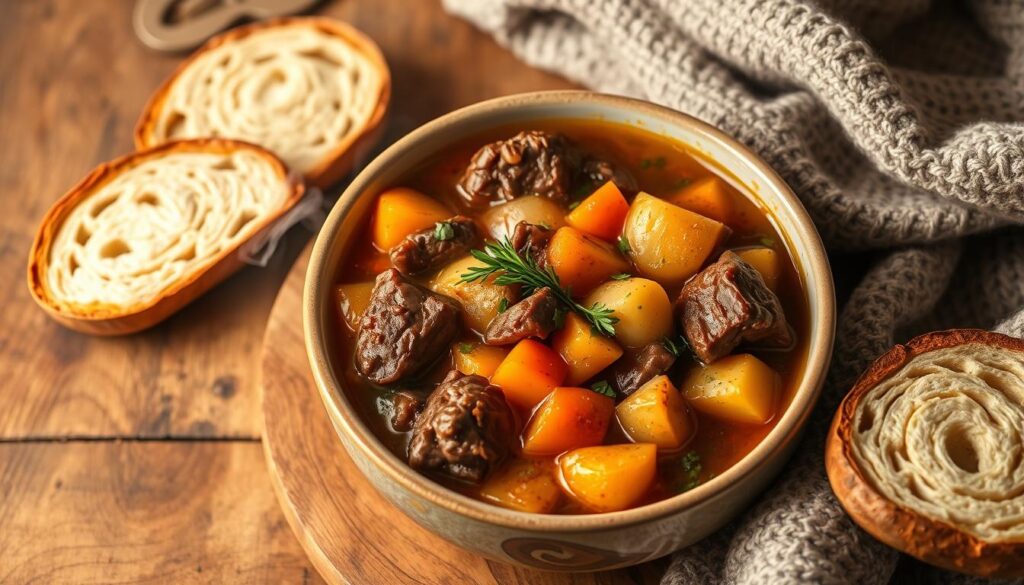Discover the secret to making a delicious and hearty beef stew recipe. Prepare a comforting and flavorful dish at home with this easy-to-follow recipe.
Table of Contents
A warm, comforting bowl of beef stew is the ultimate comfort food, perfect for a chilly evening. This hearty meal is a staple of many cuisines, offering a rich and satisfying experience that never goes out of style. With its tender chunks of beef, flavorful vegetables, and savory broth, it’s no wonder why beef stew remains a beloved favorite among many.
As we delve into the world of beef stew, we’ll explore its rich history, essential ingredients, and expert cooking techniques. From the basics of selecting the right cut of beef to the art of seasoning and reheating, we’ll cover it all. Whether you’re a seasoned cook or a culinary newcomer, this guide will walk you through the process of creating a delicious, comforting beef stew that’s sure to become a new comfort food favorite.
The Rich History of Traditional Beef Stew
Beef stew has been a staple in many cuisines around the world, with its origins dating back to ancient times. The dish has a rich stew history, with various cultures adapting and modifying the recipe to create unique variations. From hearty beef recipes in Europe to flavorful stews in Asia, the diversity of this beloved dish is a testament to its enduring popularity.
The evolution of beef stew is a fascinating story, with different regions contributing their own twist to the recipe. In Europe, beef stew was a peasant food, made with tough cuts of meat and vegetables. As the dish spread to other parts of the world, it was adapted to local tastes and ingredients. Today, we can find a wide range of beef stew variations, from the spicy stews of Korea to the rich, flavorful stews of Brazil.
- Irish stew, made with lamb or beef, potatoes, and carrots
- French bouillon, a clear broth made with beef, vegetables, and aromatics
- Korean jjigae, a spicy stew made with beef, vegetables, and gochujang
These variations demonstrate the versatility of beef stew, and how it can be adapted to suit different tastes and cuisines.
Whether you’re a fan of traditional beef recipes or prefer to experiment with new flavors, the rich stew history of beef stew is sure to inspire your next culinary adventure. With its rich flavors and hearty ingredients, beef stew is a dish that continues to captivate audiences around the world.
| Region | Beef Stew Variation | Ingredients |
|---|---|---|
| Europe | Irish Stew | Beef, potatoes, carrots, onions |
| Asia | Korean Jjigae | Beef, vegetables, gochujang, soy sauce |
| South America | Brazilian Feijoada | Beef, black beans, onions, garlic |
Essential Ingredients for the Perfect Beef Stew Recipe
When it comes to creating a delicious beef stew, the right stew ingredients can make all the difference. From tender beef cuts to fresh vegetables and aromatic seasonings, each component plays a vital role in the overall flavor and texture of the dish.
A good beef stew typically starts with a selection of high-quality beef cuts, such as chuck or round. These cuts are ideal for slow cooking, as they become tender and flavorful with time. In addition to the beef, a variety of vegetables like carrots, potatoes, and onions are typically added to the stew, providing natural sweetness and depth of flavor.
Some essential stew ingredients to consider include:
- Fresh herbs like thyme and rosemary
- Aromatic spices like bay leaves and black pepper
- Red wine or beef broth for added moisture and flavor
By combining these ingredients in the right proportions, you can create a rich and satisfying beef stew that’s sure to please even the pickiest of eaters.
| Ingredient | Quantity | Importance |
|---|---|---|
| Beef cuts | 2-3 pounds | High |
| Vegetables | 2-3 cups | Medium |
| Seasonings | 1-2 teaspoons | Low |
Selecting and Preparing Your Meat
When it comes to cooking techniques, selecting the right cut of beef is crucial for a delicious beef stew. Meat preparation is an essential step that can make or break the final result of the dish. To achieve tender and flavorful meat, it’s vital to choose the best cuts of beef for stewing.
A good understanding of meat preparation and cooking techniques can help you create a mouth-watering beef stew. Proper trimming techniques are also essential to remove excess fat and connective tissue, which can make the meat tough and chewy. By mastering these skills, you can take your beef stew to the next level and impress your family and friends.
Best Cuts of Beef for Stewing
Some of the best cuts of beef for stewing include chuck, brisket, and short ribs. These cuts are rich in connective tissue, which breaks down during cooking, resulting in tender and flavorful meat. When selecting a cut of beef, look for one with a good balance of fat and lean meat, as this will help to keep the meat moist and flavorful.
Proper Trimming Techniques
To trim your beef properly, start by removing any excess fat and connective tissue. Use a sharp knife to cut away any visible fat, and then use a pair of kitchen shears to trim any remaining tissue. This will help to prevent the meat from becoming tough and chewy during cooking.
Meat Seasoning Guidelines
Once you’ve trimmed your beef, it’s time to season it. Use a combination of salt, pepper, and your favorite herbs and spices to add flavor to the meat. Be sure to season the meat evenly, making sure that all surfaces are coated with the seasoning mixture. By following these meat preparation and cooking techniques, you can create a delicious beef stew that’s sure to please even the pickiest of eaters.
| Cut of Beef | Best Use |
|---|---|
| Chuck | Stewing, braising |
| Brisket | Stewing, slow cooking |
| Short Ribs | Braising, stewing |
Step-by-Step Cooking Instructions
To achieve the perfect beef stew, it’s essential to follow a series of recipe instructions that guide you through the cooking process. This section will provide a comprehensive guide on the various cooking methods you can use to prepare a delicious beef stew.
First, you’ll need to brown the meat, which can be done using a stovetop or oven. This step is crucial in developing the flavor of the stew. Next, you’ll need to cook the vegetables, such as carrots, potatoes, and onions, until they’re tender. You can use a variety of cooking methods, including sautéing or roasting, to achieve the desired texture.
Once the meat and vegetables are cooked, you can combine them with some broth and let the stew simmer. This can be done using a stovetop, oven, or slow cooker, depending on your preference. The key is to let the stew cook slowly, allowing the flavors to meld together and the meat to become tender.
Here are some tips to keep in mind when following recipe instructions for beef stew:
- Use a heavy pot or Dutch oven to distribute heat evenly
- Brown the meat in batches to prevent overcrowding the pot
- Don’t overcook the vegetables, as they can become mushy
- Let the stew simmer for at least an hour to develop the flavors
By following these cooking methods and tips, you’ll be able to create a delicious and hearty beef stew that’s perfect for any occasion. Remember to always follow recipe instructions carefully and adjust the seasoning to taste.

| Cooking Method | Cooking Time | Temperature |
|---|---|---|
| Stovetop | 1-2 hours | Medium-low heat |
| Oven | 2-3 hours | 300°F (150°C) |
| Slow Cooker | 6-8 hours | Low heat |
Mastering the Art of Seasoning
To create a delicious beef stew, it’s essential to follow proper seasoning guidelines. This involves using a combination of herbs and spices to enhance the flavor of the dish. By understanding the basics of flavor enhancement, you can take your beef stew to the next level.
When it comes to seasoning, there are a few key elements to consider. First, it’s important to choose the right herbs and spices for your dish. Some popular options include thyme, rosemary, and bay leaves. You can also use spices like paprika and garlic powder to add depth and complexity to your stew.
In addition to choosing the right herbs and spices, it’s also important to consider the timing of your seasoning. You can add seasoning at various stages of the cooking process, from the initial browning of the meat to the final simmering of the stew. By adjusting your seasoning during cooking, you can build layers of flavor and create a rich, harmonious taste experience.
Essential Herbs and Spices
- Thyme: adds a savory, slightly minty flavor
- Rosemary: provides a piney, herbaceous flavor
- Bay leaves: contribute a mild, slightly sweet flavor
By following these seasoning guidelines and using a combination of herbs and spices, you can create a beef stew that is full of flavor and sure to please even the pickiest eaters. Remember to taste and adjust your seasoning throughout the cooking process to ensure the perfect balance of flavors.
Common Mistakes to Avoid
When cooking beef stew, it’s essential to be aware of common mistakes that can lead to cooking pitfalls. One of the most frequent errors is overcooking the meat, which can result in a tough and dry texture. To avoid this, it’s crucial to monitor the cooking time and temperature, ensuring that the meat is cooked to the recommended internal temperature.
Another common mistake is underseasoning, which can leave the stew tasting bland and unappetizing. To prevent this, it’s vital to use high-quality ingredients and to season the stew generously, taking into account the flavors and aromas of the various ingredients. Some common mistakes to watch out for include:
- Using low-quality ingredients, such as tough cuts of meat or stale spices
- Not browning the meat properly, which can lead to a lack of flavor and texture
- Not deglazing the pan, which can result in a loss of flavorful browned bits
- Overcrowding the pot, which can lead to uneven cooking and a higher risk of common mistakes
By being mindful of these common mistakes and taking steps to avoid them, you can ensure a successful and delicious beef stew. As professional chefs often say, “the key to a great stew is in the details,” and by paying attention to these details, you can create a truly exceptional dish.
Some additional tips to keep in mind include using a thermometer to ensure the meat is cooked to a safe internal temperature, and to not stir the stew too frequently, which can disrupt the formation of the flavorful crust on the bottom of the pan. By following these tips and avoiding common mistakes, you can create a beef stew that is both delicious and memorable.
| Common Mistake | Prevention Tip |
|---|---|
| Overcooking the meat | Monitor cooking time and temperature |
| Underseasoning | Use high-quality ingredients and season generously |
| Using low-quality ingredients | Choose fresh and high-quality ingredients |
Storage and Reheating Guidelines
After cooking a delicious beef stew, it’s essential to store and reheat it properly to maintain its quality and flavor. This section will provide guidelines on storage methods and reheating techniques to ensure food safety and preserve the stew’s taste.
When it comes to storing beef stew, it’s crucial to use airtight containers to prevent contamination and spoilage. Some effective storage methods include using glass or plastic containers with tight-fitting lids or freezer bags. It’s also important to label and date the containers so you can easily keep track of how long they’ve been stored.
Proper Storage Methods
- Use airtight containers to prevent contamination and spoilage
- Label and date containers for easy tracking
- Store in the refrigerator at a temperature of 40°F (4°C) or below
Safe Reheating Techniques
To reheat beef stew safely, it’s recommended to use reheating techniques such as microwaving or stove-top heating. When reheating, make sure the stew reaches a minimum internal temperature of 165°F (74°C) to prevent foodborne illness.
Freezing Instructions
If you want to store beef stew for an extended period, freezing is a great option. To freeze, simply place the stew in airtight containers or freezer bags and store in the freezer at 0°F (-18°C) or below. When you’re ready to reheat, simply thaw the stew overnight in the refrigerator and reheat using your preferred reheating techniques.
| Storage Method | Temperature | Shelf Life |
|---|---|---|
| Refrigerator | 40°F (4°C) | 3-5 days |
| Freezer | 0°F (-18°C) | 3-6 months |
Recipe Variations and Modifications
Exploring different recipe variations can elevate your beef stew game, allowing you to create unique dishes tailored to your tastes and preferences. One way to start is by experimenting with various ingredients, such as swapping traditional beef for bison or lamb, or adding unconventional vegetables like parsnips or turnips.
Another approach is to incorporate modification ideas from global cuisines. For instance, you can add a splash of soy sauce and ginger for an Asian-inspired flavor or use cumin and chili powder for a Mexican twist. The key is to balance flavors and textures, ensuring that each component complements the others.
Some popular recipe variations include:
- Beef and Guinness stew, featuring the rich flavors of Ireland’s iconic stout
- Beef and mushroom stew, highlighting the earthy flavors of sautéed mushrooms
- Spicy beef stew, adding a kick with diced jalapenos or red pepper flakes
When experimenting with modification ideas, remember that the possibilities are endless. Don’t be afraid to try new combinations and adjust seasonings to taste. With a little creativity, you can create a truly unique beef stew that showcases your personal style.

Conclusion
As we conclude this exploration of the classic beef stew recipe, it’s clear that this hearty dish holds a cherished place in culinary history. From its humble origins to the myriad regional variations worldwide, the art of crafting the perfect beef stew is a testament to the enduring power of simple, wholesome ingredients and time-honored cooking techniques.
By following the guidance outlined in this article, home cooks can unlock the secrets to creating a beef stew that is not only deeply flavorful but also a true reflection of their culinary skill and personal flair. Whether you choose to stick to the traditional recipe or experiment with innovative twists, the key is to embrace the process, savor the aromas, and revel in the satisfaction of serving a homemade masterpiece.
So, gather your ingredients, set aside some time, and embark on a culinary journey that will transport you to the heart of comfort food bliss. The final result will be a dish that not only nourishes the body but also warms the soul, creating lasting memories and bringing people together around the table.



